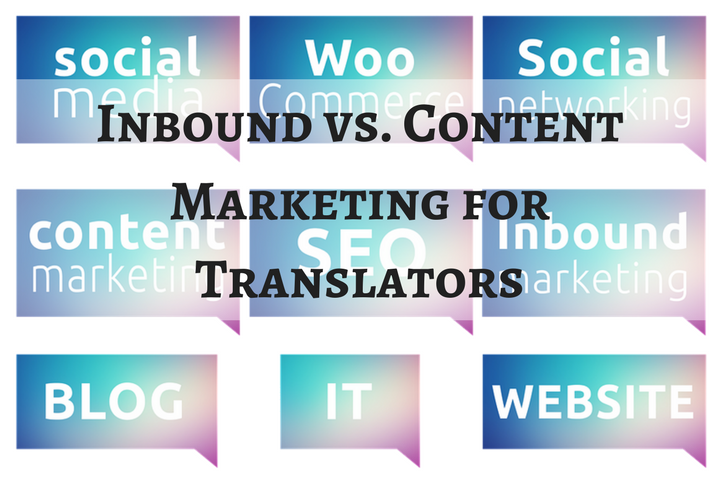
Episode 163: Everything a Freelance Translator Needs to Get Things Done – Interview with Caroline Bries
03/19/2018How to find more or better clients
04/02/2018There is no way to get around it, marketing is a vital part of your freelance translation business. However, one aspect of marketing can make finding clients a little bit easier. I am talking about inbound marketing, or how to attract clients to you. But what is inbound marketing? There is a misconception that inbound marketing starts and ends with content. This article is explaining the difference between the two, and why it matters for freelance translators.
What is Inbound Marketing?

Brian Halligan, a former HubSpot CEO, is credited with creating the term ‘inbound marketing.’ Though synonymous with the concept of ‘permission marketing’ coined by Seth Godin in 1999, the former term is by far the most popular. While outbound marketing plays the part of active hunter, launching themselves after potential customers, trying to catch their attention with in-your-face advertisements, cold-calling, and direct response campaigns, inbound marketers play the part of ambush predators. They create awareness and wait for customers to find them.
In short, inbound marketing is the set of methods and technologies that helps a company find leads, capture public interest, drive purchases, and organically increases traffic. Content marketing is just one tool in the inbound marketer’s toolbox.
The Goals and Tools of Inbound Marketing
To be great at inbound marketing, your translation business must also succeed at:
- Capturing Contact Information: This involves collecting contact information for potential customers via website tracking tools or web-based forms. For example, a Swedish/French/Spanish translator may offer customers a free quote in return for their e-mail or phone number. Many sites also offer potential clients discounts or free content to secure this information.
- Placing Calls-to-Action: You must be selective about where and how you structure your calls-to-action. Do not make your ‘Get Your Translation Quote’ buttons obtrusive or distracting or turn your blogs into poorly-written advertisements.
- E-mail Marketing: While content marketing is great for building awareness of your translation services, it is not well-suited for turning leads into sales. E-mail allows you to personalize your message in a way that guides clients further down the sales funnel. If done well, these targeted e-mails can turn a curious reader into an avid buyer.
- Search Engine Optimization: People rarely venture beyond the first page or two in Google search. This means lost business for any translator not in the ‘Goldilocks’ zone. If your translation firm can’t afford to hire an SEO professional, do everything you can to learn about how search engines and indexing work. Just a few simple steps can be enough.I have created a checklist with the most important things to consider for an optimized website that attracts clients.

- Social Media Marketing: People love social media. Companies SHOULD love social media. It offers business people, such as translators, a new way to connect with their customers. Use your company’s social media pages to not only highlight your services but to bring a touch of humanity to your business.
What is Content Marketing?
Content marketing is the use of content, such as blogs or white papers, to market your services. While most commonly associated with the internet, content marketers also make use of physical items, like brochures and newspaper articles, to drive sales.
Here are some examples of content marketing in action:
- A Swedish/French/Spanish translator posts a series of articles answering the most frequent questions about the life and culture of their country. This helps attract people curious about the culture of the country.
- A new Spanish-to-English translator produces a well-researched white paper promoting the importance of offering Spanish translations of business websites. The empirical evidence contained, especially when coupled with an e-mail campaign, may help push uncertain customers over the fence.
- An experienced Spanish translator that works in an industry oversaturated by low-cost translation agencies, posts a long-form article outlining the advantages a small freelance company offers over a larger agency. This may help customers debating between a large agency and a freelancer select the latter.
The Tools of Content Marketing
Well-written, well-optimized content is a wonderful way to build a reputation for your translation company. By making good use of keywords, and answering questions your clients care about, you shoot to the top of their reference list. Tools used by content marketers include:
- Blogging: A blog is a page, typically run by an individual, that is typically filled with posts written in a conversational style. Due to their low price, and overall effectiveness, blogs are one of the most popular content types. But, they’re rather pointless if they are unactionable or poorly-written. To get some ideas for how a blog for your translation company might look, please visit http://foxdocs.biz/BetweenTranslations.
- Case Studies: Case studies examine a scenario to provide readers with knowledge and actionable information. In the content marketing world, these often detail customer success stories and outline the benefits your firm provided. Case studies are a great way to show-off your firm’s unique strengths and abilities.
- eBooks: eBooks are a type of digital book formatted to be read from a desktop, tablet, or e-reader. Content marketers often offer e-books in exchange for contact information. These informative books are often sourced out to reputable freelance writers.
Conclusion
Content may be essential to inbound marketing, but it cannot replicate the results of a comprehensive inbound marketing plan on its own. If you’re a translator hoping to make the most of inbound or content marketing, stay tuned for an upcoming free webinar.
In the meantime, don’t forget to get the free checklist with 18 easy steps to an optimized website for inbound marketing. Click below to download it now.



